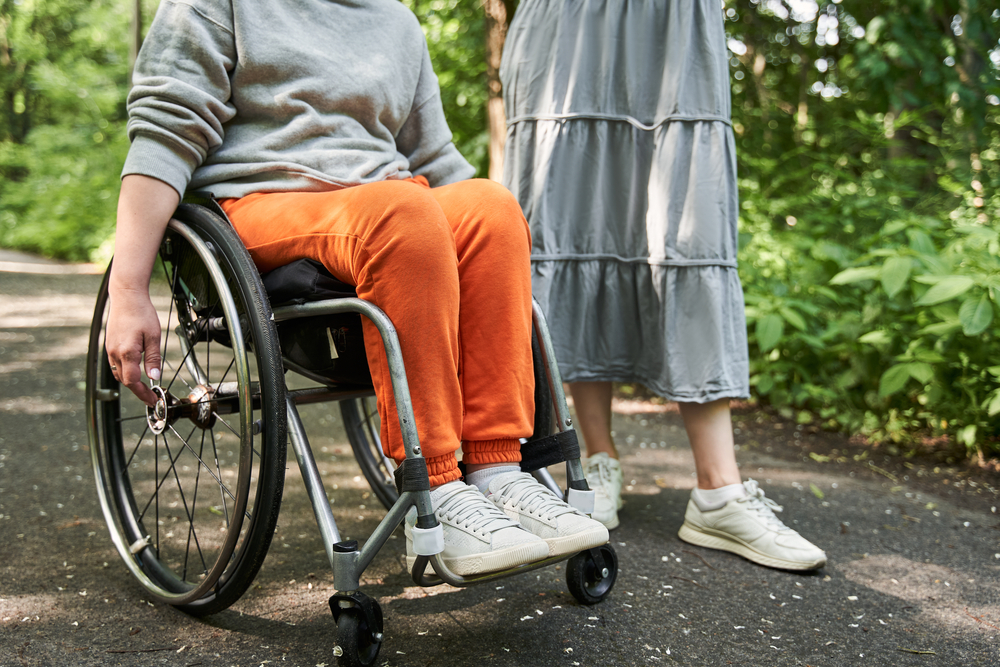
ADA camping is an important part of making sure the outdoors are accessible and inclusive for everyone! Campers looking for accessible camping need campgrounds with flat layouts that are easy to navigate in a wheelchair. There are other considerations for parks and attractions to accommodate people with disabilities as well. Video captioning at visitor centers, sign language interpreters, maps and brochures available in Braille, audio descriptions for exhibits and displays – these are all important parts of making sure an experience is accessible to everyone.
We’re going to take a look at how to find ADA camping sites, how to find national parks that accommodate people with different needs, and what to bring on a camping trip.
Wheelchair Accessible Campsites
The ADA does have requirements for campgrounds to be compliant so that everyone has equal access to camping. However, not every campground meets these guidelines. Or they may meet some of the requirements, but not all of them.
Wheelchair accessible campsites should not have obstructions like boulders or posts placed so close together that wheelchairs can’t pass between them. They shouldn’t have steep hills to maneuver through the campsite. They should have relatively smooth terrain and hard packed dirt or pavement so wheelchairs can be rolled through. Picnic tables should be altered to allow wheelchairs to pull up to the table.
Campground bathrooms should have wide doors to allow wheelchair access. There should be accessible stalls with grab bars. And trails to the bathrooms should be wide and easy to travel in a chair.
Campgrounds should also accommodate service animals, and have a relief area for them.
Many campgrounds with online reservation systems will detail the accommodations they have for accessible sites. But if the description is unclear, or you want more peace of mind, you can also call and speak with the campground owner. Hipcamp, which lists campsites across the country, has a special search feature to look for ADA camping, and there’s an easy feature to contact the campground owner.
The U.S. Forest Service also has a guide to camping on the 193 million miles of forests and grasslands across the country. The interactive visitor map shows you accessible campsites on U.S. Forest Service lands.
ADA camping sites at popular destinations do go quickly, so you’ll want to make reservations as soon as possible.
Finding Accessible National Parks
About ten years ago, the National Park Service put together an accessibility plan to make the parks easier for those with special needs to navigate. You can find a complete breakdown of accessible features at the parks by using this interactive map.
Here are a few popular parks and the features they have to make them more ADA camping compliant.
Yellowstone National Park
All campgrounds at Yellowstone have at least one wheelchair accessible campsite. There are also two backcountry campsites that can accommodate wheelchairs. A boardwalk system at the park allows people who are walking or using a wheelchair to see Old Faithful and other geysers and geothermal activity. The visitor center has been renovated. The park also provides:
- Sign Language Interpreters – must be requested three weeks ahead of time for ranger programs
- Captioning on visitor center videos
- Assistive Listening on visitor center videos
- Audio Descriptions for the Yellowstone map & guide and for some self-guided trails
- Large Print & Braille versions of the Yellowstone map & guide
- Service Animals are allowed in many areas where other pets are prohibited
Grand Canyon National Park
Historic facilities at the Grand Canyon were built before the current accessibility standards, and may not meet those standards. Park shuttle buses are accessible, although wheelchairs and scooters larger than 30 inches wide by 48 inches long can’t be accommodated on buses.
There are several canyon lookouts that are accessible, and there is a scenic drive accessibility permit that allows visitors with special needs to access some areas that are off-limits to other visitors. Mule rides and rafting trips at the bottom of the canyon are run by contractors, but those vendors can often accommodate people with accessibility needs.
The park also has wheelchair-accessible campsites at several campgrounds
Yosemite National Park
Yosemite has accommodations throughout the park for people needing accessible areas. Yosemite’s accessibility guide is the most complete list of the facilities available at the park.
The park will provide a sign language interpreter, but two weeks’ notice is required. There are also assistive listening devices and captioning for videos. Many of Yosemite’s sights can be seen by car. There is a medical clinic available in Yosemite Valley.
Three campgrounds in Yosemite Valley have designated ADA camping – Lower Pines, Upper Pines, and North Pines. Accessible sites have paved trails to the bathrooms, level tent pads, accessible fire rings, and picnic tables with extended tops. Lower Pines also has two sites with electric power to charge a wheelchair. Because of the park’s popularity, accessible campsites fill up quickly, and you’ll want to make a reservation as soon as possible.
Choosing an Accessible RV Rental
Many RVs are accessible for those in wheelchairs as well. You can look for RVs that have:
- Ramps or lifts for wheelchair users to get into the RV
- Roomier doorways so wheelchairs will fit
- Open floor plans so wheelchairs can move easily through an RV
- Lower counters and tables so those in wheelchairs can prepare meals, eat, and use the table
- Extendable dinettes and recessed sink cabinets so wheelchair users can access the sink or table
- Accessible showers
As you look for accessible RVs, you may find that some rigs have some of these features but not all. And some features may be more important to your comfort as you travel. You may want to think about which feature are essential to you as you travel, and which you can either do without or wait until later to add.
RV manufacturers who are making accessible RVs include Newmar, Winnebago, Harbor View Trailers, and Dune Sport Custom Toy Haulers.
You can also have an RV altered after you buy it to make it more suitable for ADA camping. Some people retrofit their own RVs, but you can also hire a company like Access Unlimited, Creative Mobile Interiors, or Star Tracks Custom Seat Lifts to make upgrades for you.
If you’re looking for an RV rental, RVshare is the largest online RV marketplace. You’ll find thousands of RVs listed by their owners. Once you’ve found some RVs that look like good options for you, you can email the owners to ask any questions you might have about their vehicles.

Accessible Outdoor Adventure Programs
There are also groups that organize campouts, with the goal of encouraging and assisting campers with special needs. Groups like CampAbility, Adaptive Adventures, and Outdoors For All have programs to encourage those with physical disabilities to get outside. They facilitate trips to go camping, rafting, cycling, and to try many other outdoor activities.
You can also check for adaptive programs or accessible outdoor activities in your own area by searching online.
Essential Camping Gear
Some of the gear you’re going to bring camping is the same as that of non-disabled campers. However, special needs campers may require some extra gear. You can tailor your packing list, depending on your own unique needs.
Accessible Camping Gear
- Accessible Tent: A tent with a larger door, lower profile, or wheelchair access. You may also want a tent with a large vestibule where you can store your wheelchair to protect it from the elements.
- Elevated Sleeping Cot: A cot may be easier for those with mobility issues to transfer from a chair.
- Blankets: Blankets can be easier to use than more constricting sleeping bags.
- Adjustable Air Mattress: Can be inflated to the desired firmness.
- All-Terrain Wheelchairs: These chairs are designed for rough terrain. If you don’t have an all-terrain wheelchair, several states including Kansas, Colorado, South Dakota, and Oklahoma have state parks where you can rent a track chair to take on hiking trails.
- Adaptive Utensils: Lightweight utensils with specialized grips for easier use.
- Supportive Seating: Chairs with extra support, cushioning, or those designed for ease of transfer.
- Adaptive Clothing: Clothing with Velcro fastenings, easy zippers, or magnetic closures for easier dressing.
- Portable Ramps: Lightweight ramps for navigating uneven ground or getting in and out of tents.
- Portable Commode: For use inside tents or RVs at night.
- Toilet Seat Risers: To make using a standard camp toilet easier.
- Adaptive Fishing Gear: Rod holders, accessible fishing chairs.
- Adaptive Kayaks or Canoes
- Emergency Alert Devices: Personal alarms or GPS trackers for added safety.
- Large Print Maps: For those with visual impairments.
- Flashing Light Alerts: For those with hearing impairments.
- Communication Devices: Tablets or communication boards for non-verbal campers.
- Customizable First Aid Kit: Include any necessary medications, medical supplies, or items related to specific health needs. Bring backup batteries or a portable charger for hearing aids and other devices requiring a charge.
General camping gear
- Cooking Supplies: Portable stove, fuel, pots, pans, utensils, and food storage containers.
- Cooler: For keeping food and drinks cold.
- Water Bottle/Hydration System: For carrying water on hikes or around the campsite.
- Lighting: Headlamps, lanterns, and extra batteries.
- Navigation Tools: Map, compass, or GPS device.
- Footwear: Comfortable, supportive shoes or boots.
- Personal Hygiene Items: Biodegradable soap, toothbrush, toothpaste, and wipes.
- Multi-tool or Knife: Useful for various tasks around the campsite
Top Tips for Wheelchair Camping
Along with looking for accessible campgrounds and RVs, considering accessible outdoor adventure programs, and packing the essential camping items, here are a few more tips for wheelchair camping.
Look for discounts
Many attractions and destinations offer discounts if you have a disability. The National Park Service has an Access Pass for people who have a permanent disability. The pass allows you free entry to more than 2,000 recreation sites. It may also allow discounts on extra amenities like camping, swimming, boat launching, guided tours, and more.
Many state parks have their own pass for visitors with disabilities.
Travel with a friend
Many people with disabilities prefer to camp with a companion who can help set up the tent, cooking supplies, and other tasks. You may want to consider this at least for the first few times you camp.
Don’t forget about hygiene
We covered this a little bit with the packing list, but you may want to consider a portable camp toilet for nighttime trips. Some people recommend setting up a large tent with a divider, with sleeping space on one side and hygiene space and a portable toilet on the other, and some people use a separate privacy tent. Consider packing a shower chair, or bringing a ground-based portable shower. If you’re RVing, be sure that the rig you’re using has an accessible bathroom and that you can get to it easily in the night.
Camp close to home
This is a good tip for anyone heading out on one of their first camping trips! Pick a camping spot that isn’t too far from home. A long drive, followed by setting up camp and getting settled, can be exhausting. It also doesn’t leave you a lot of margin for error. Pick somewhere that won’t require a long road trip, so you arrive at camp with the energy you’ll need to set everything up for the first time. Also, if the trip really just isn’t working, you can return home and try again another time.
Hopefully, this article has given you tips and resources for your next ADA camping trip! It is definitely possible for people with disabilities to have a successful, enjoyable time in the outdoors.






